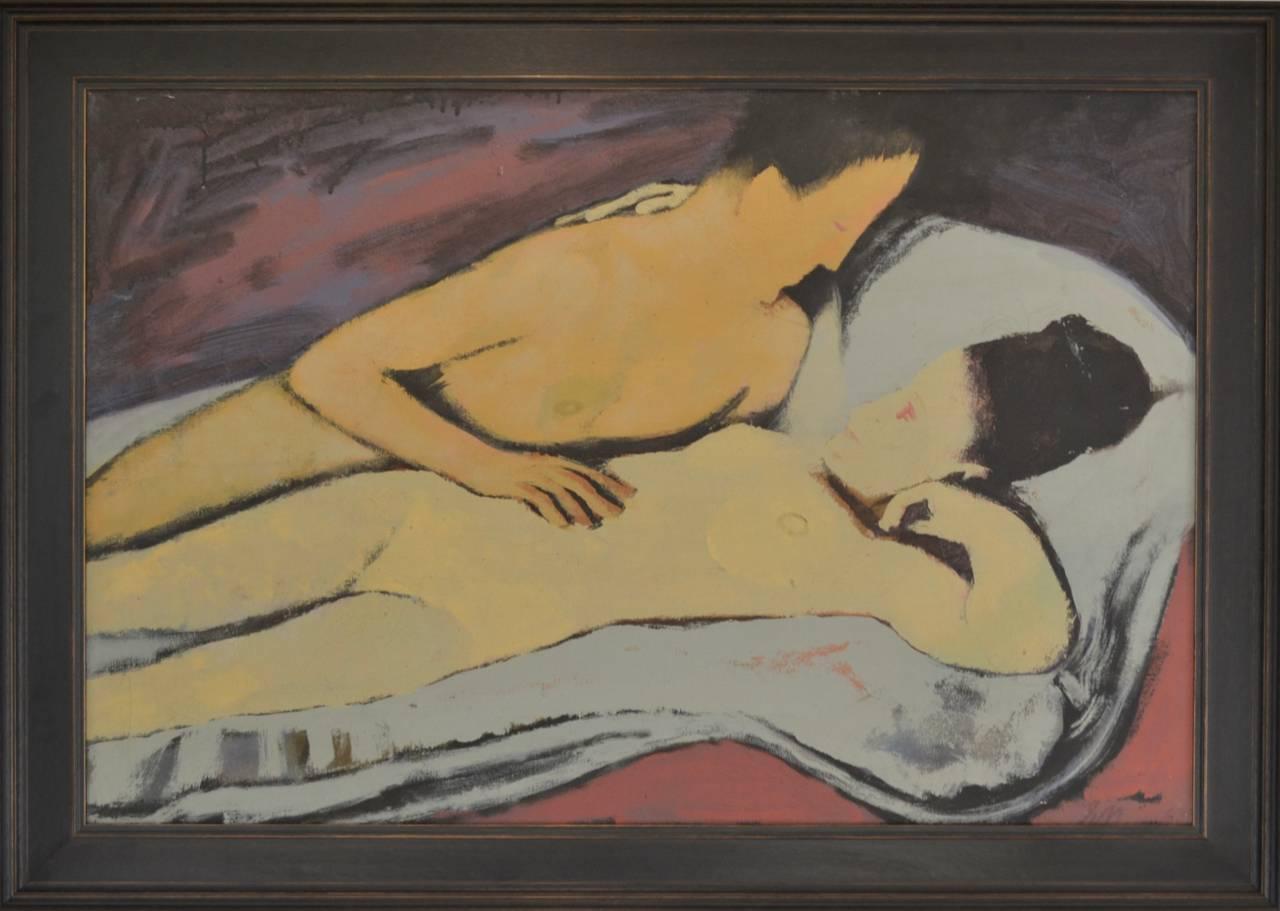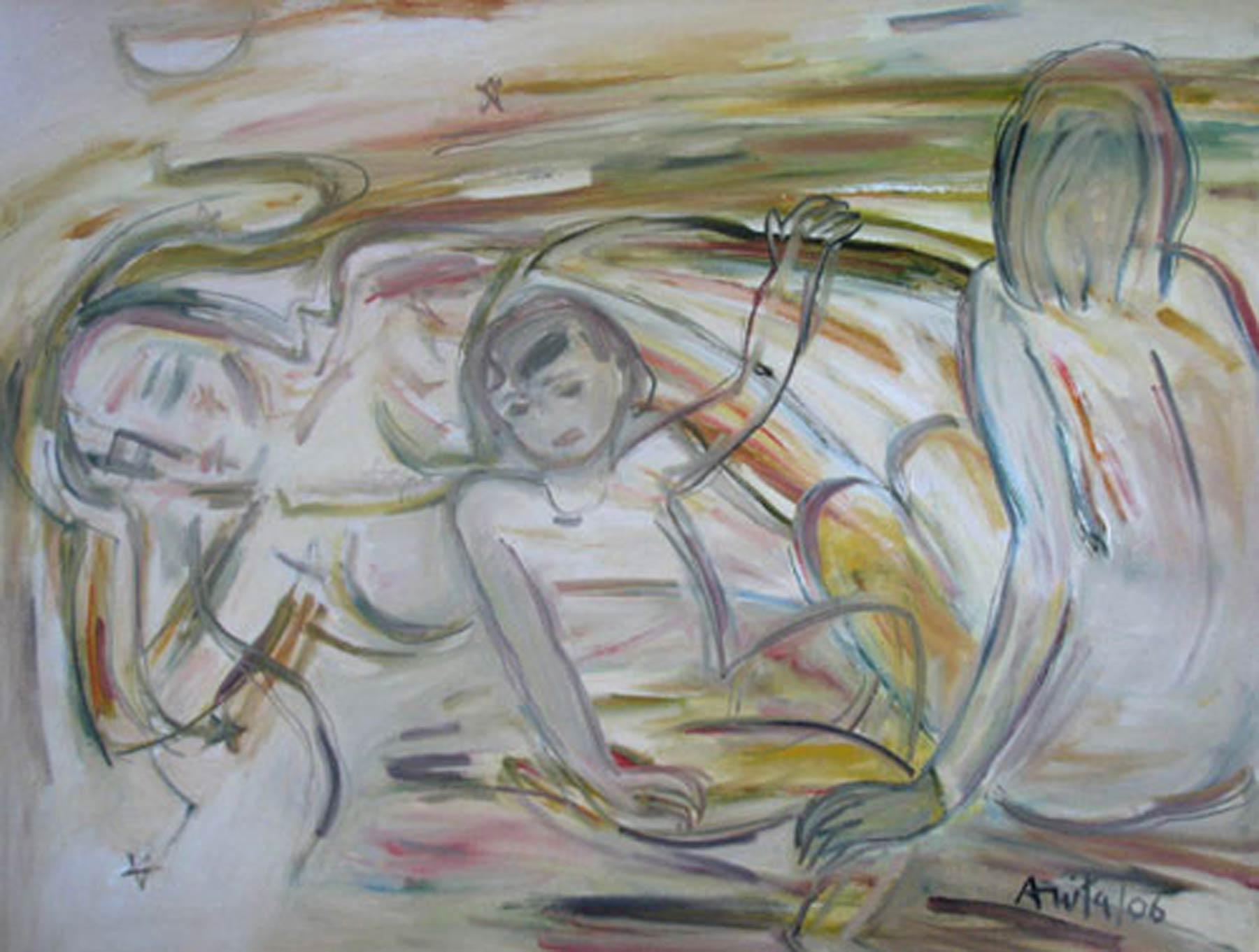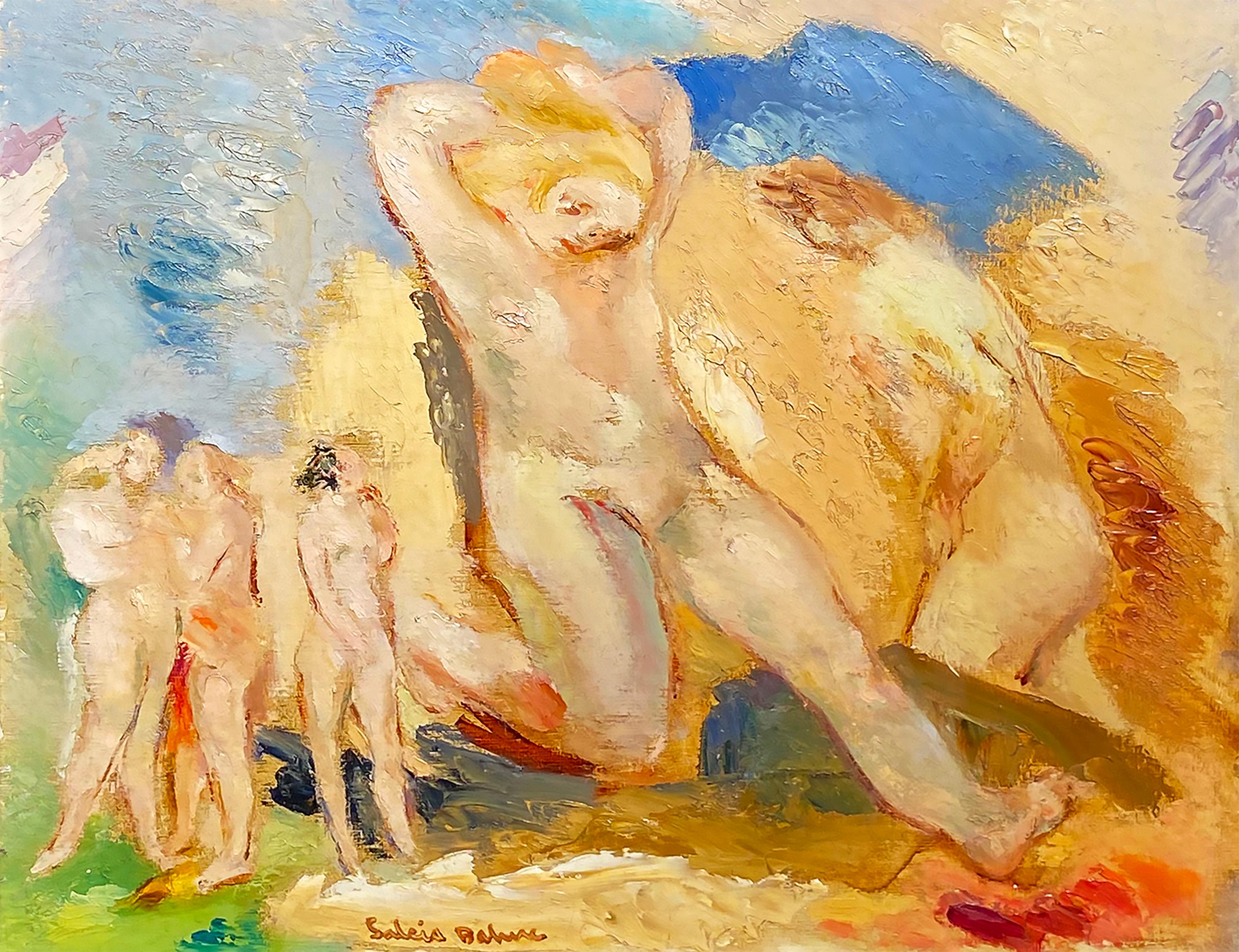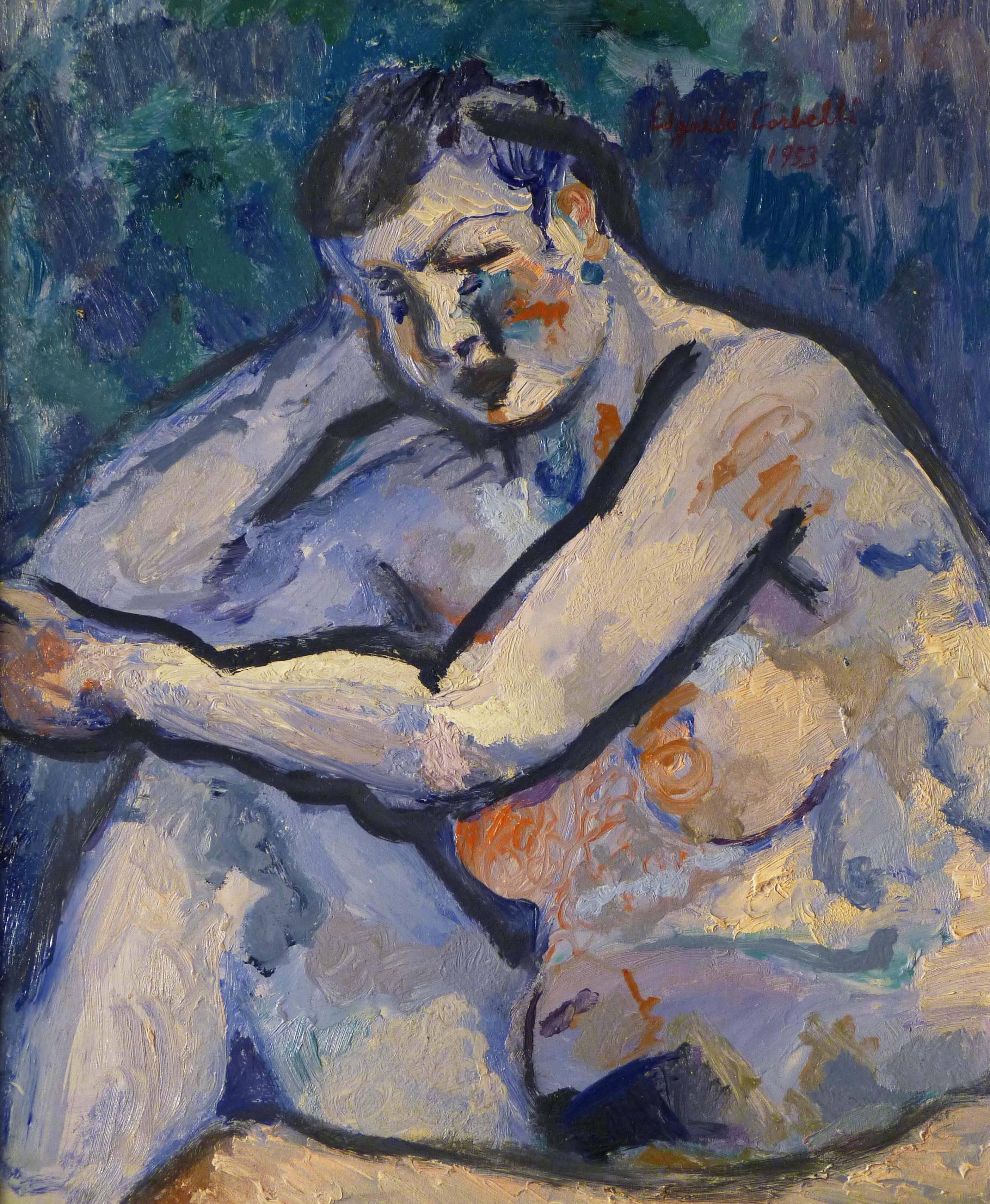Items Similar to Huge 20th Century French Oil on Canvas - Adam & Eve Grey Black & White Oval
Want more images or videos?
Request additional images or videos from the seller
1 of 9
French ExpressionistHuge 20th Century French Oil on Canvas - Adam & Eve Grey Black & White Ovalc. 1990's
c. 1990's
About the Item
Adam & Eve
French School, late 20th century
oil painting on canvas, 140c x 113cm
provenance: private collection, Paris
Striking and bold portrayal of these two nude lovers, entwined but seperate too. The subject could represent a number of couples, but we understand from the former owner that it is depicting Adam & Eve.
Painted on this epic scale and in monotone palette, it is utterly captivating and ideal for a large space. Timeless in its appeal, yet possessing a modern feel to it at the same time.
Condition:
very good
- Creator:French Expressionist
- Creation Year:c. 1990's
- Dimensions:Height: 55.12 in (140 cm)Width: 44.49 in (113 cm)Depth: 1.58 in (4 cm)
- Medium:
- Movement & Style:
- Period:
- Condition:
- Gallery Location:Cirencester, GB
- Reference Number:1stDibs: LU50936526212

About the Seller
5.0
Platinum Seller
These expertly vetted sellers are 1stDibs' most experienced sellers and are rated highest by our customers.
Established in 1989
1stDibs seller since 2016
3,472 sales on 1stDibs
Typical response time: 2 hours
- ShippingRetrieving quote...Ships From: Cirencester, United Kingdom
- Return PolicyA return for this item may be initiated within 3 days of delivery.
More From This SellerView All
- 1930's French Modernist Oil Portrait of Nude Lady abstract settingLocated in Cirencester, GloucestershireThe Nude Model French School, 1930's oil on canvas 21.5 x 15 inches double sided work provenance: private collection, Paris The painting is in sound condition, some former restoratio...Category
1930s Modern Figurative Paintings
MaterialsOil, Canvas
- Huge 1900's Italian Impressionist Signed Oil Painting Shepherd Talking to NudeLocated in Cirencester, GloucestershireShepherd with Flock and Nude Lady by Fountain Italian School, circa 1900's indistinctly signed, 'R. Bertholio'? signed oil on canvas, unframed canv...Category
Early 20th Century Impressionist Figurative Paintings
MaterialsCanvas, Oil
- Huge Contemporary Oil Painting Nude Lady against Red Background signedLocated in Cirencester, GloucestershireThe Nude Model European School, contemporary signed oil on canvas, unframed canvas: 39 x 39 inches provenance: private collection, France condition: very good and sound conditionCategory
21st Century and Contemporary Modern Nude Paintings
MaterialsCanvas, Oil
- Cupids Playing Very Large Bacchanal Rococo Scene Antique oil paintingLocated in Cirencester, GloucestershireBacchanal Cupids Playing French School, early 1900's oil painting on canvas, framed canvas: 22 x 39 inches framed: 27 x 44 inches Large scale French Rococo style oil painting on ca...Category
Early 20th Century Rococo Figurative Paintings
MaterialsOil, Canvas
- Large French 20th Century Oil Nude Lady Reclining, in the Style of PicassoLocated in Cirencester, GloucestershireArtist/ School: French School, late 20th century Title: The Nude Model, in the style of Picasso Medium: oil painting on canvas, framed frame...Category
20th Century Abstract Figurative Paintings
MaterialsCanvas, Oil
- FINE 17TH CENTURY ITALIAN OLD MASTER OIL ON CANVAS - THE BATHING OF BATHSHEBALocated in Cirencester, GloucestershireArtist/ School: Italian School, 17th century Title: The Bathing of Bathsheba Medium: oil painting, on canvas Size: frame: 23 x 19 inches, canvas: 18 x 14 inches Provenanc...Category
17th Century Old Masters Figurative Paintings
MaterialsOil, Canvas
You May Also Like
- "Erste Beruhrung" First StirringsBy Ernst NeuschulLocated in Brecon, PowysOil on canvas, signed and dated 'EN [19]63' lower right, titled and dated to stretcher, numbered 33 and with paper label 34 to stretcher, From the family of the artist by direct des...Category
1960s Expressionist Figurative Paintings
MaterialsOil, Canvas
- Mother & Child, Nude Oil paint, Earth Colours by Indian Modern Artist "In Stock"By Anita Roy ChowdhuryLocated in Kolkata, West BengalAnita Roy Chowdhury - Mother & Child - 36 x 48 inches ( unframed size) Oil on canvas Inclusive of shipped in roll form. Style : Her works manifest human figures, nude or draped in d...Category
Early 2000s Expressionist Figurative Paintings
MaterialsOil, Canvas
- NudesLocated in Missouri, MONudes By. Salcia Bahnc (Polish, American, 1898-1976) Signed Lower Middle Unframed: 14 x 18 inches Framed: 23 x 26 inches Painter, illustrator, printmaker, teacher. Born in Dukla, Poland. Though she was born in Dukla, a town in south-eastern Poland, she moved to Prsemysl, one of the largest and most ancient cities of southern Poland, at a young age. Her mother was reportedly descended from the "Van Ast" family, a Dutch dynasty that produced several artists, including Balthasar van der Ast (1593/4 - 1657). According to one art historian she came to New York at the age of five (c. 1903), and another, at the age of eight (c. 1906). Her family was Jewish and reportedly quite wealthy. Why they would have left imperial Austria, under whose sovereignty either of her proposed birth cities were under, is unknown. However, while these areas did not suffer the pogroms typical in neighboring imperial Russia, the Austro-Hungarian empire had become much more anti-Semetic, which may have hasten there departure. How, according to one source, they ended up living in the Jewish ghetto of New York is extremely puzzling. Did they loose their wealth to some business disaster? Where they forced to leave it behind? Was there some familial tragedy? We may never know. In her youth she lived first in New York City and then in Boston, Massachusetts, where her family had relatives. It is reported that when she was in fourth grade she was found to be so competent in drawing that for the next two years she taught a drawing class after school for the other children. In Boston, Bahnc's mother eventually remarried and moved the family to Chicago where the young artist was primarily raised. In Chicago she worked during the days as a sales clerk in a department store. At night she put herself through school at the School of the Art Institute of Chicago (SAIC) and taught at her former alma mater after her graduation during the years 1923-1929. She also studied at the Chicago Academy of Fine Art. She took up design work and began exhibiting painted silk creations at a private Chicago gallery (probably Thurber, see below). The first museum exhibitions she is known to have participated in were held at the Art Institute of Chicago. During this period she became known for her portraits. Originally a resident alien, she was naturalized at the district court of Chicago, Illinois in July of 1913. In 1920 she lived on East Ontario Street in Chicago in a neighborhood filled with art studios and artists, including James Allen Saint-John (1872-1957), Paul Bartlett (1881-1965), Pauline Palmer (1867-1938), and George Ames Aldrich (1872-1941). It is in Chicago that she saw her greatest success as an artist. In 1927, Chicago art dealer Chester H. Johnson said of her work: "The Art of Salcia Bahnc is a sincere manifestation of the spirit we know as 'Modernism' . . . . . . She is the spirit of the Age, not its Fashion." Local reviewers agreed, one going as far to say that her exhibition was " . . . the most interesting one man show by a young artist that has ever been presented to Chicago, and I keep telling myself that New York will get her if we don't watch out." She was apparently a favorite and friend of art critic Clarence Joseph Bulliet (1883-1952), who authored a number of books and articles that praised Bahnc's work. Bulliet was central in introducing and popularizing modern art in the mid-western United States. In his book Apples and Madonnas: Emotional Expression in Modern Art (1935) he called Bahnc a "A thorough Expressionist." A year later in his book The Significant Moderns and Their Pictures (1936) he noted that one of her paintings of a nude was ". . . powerful in its elemental brutality." During this period other critics reported positively on the work she was producing. Ida Ethelwyn Wing reported in a volume of the Delphian Text (1930) that Bahnc, was without doubt, ". . . the most vigorous and intensively original of the American Expressionists." Paul Masserman and Maxwell Baker said of her in their work The Jews come to America (1932) that she was part of a group of artists that were "Chief among modern Jewish painters. . . " Salcia Bahnc traveled back and forth to Europe during the late 1920s and into the 1930s, a period when she faced the rise of totalitarianism. She wrote about this fact to a fellow artist to whom she commented " . . . about the difficult art scene in Paris . . . . . . and the growing power of fascism." In 1930 she was maintaining a studio in New York City at 1218 East 53rd Street and a residence in Brooklyn, Long Island. She returned to France where she married a French citizen and writer named Eugene Petit (b. 1901) and bore a son there named Alain Petit (b. 1934). She again returned to the United States in November of 1937 and traveled back to France after a brief stay in America. During her stay she continued to exhibit in Chicago, where Quest Galleries gave her a solo show. Like so many ex-patriot authors and artists who were living in Paris, she found herself trapped in France (first in Paris, then in Mayenne) following the German invasion in 1940. Being of Jewish extraction the situation could prove to be quite dangerous if she were reported or discovered by German authorities. She and her husband were able to obtain passports and escape to Portugal where in August of 1941 they boarded the S. S. Escambion to return to America. In 1940, American Export Lines, owners of the Escambion, discontinued its normal Mediterranean routes and placed their ships into service sailing from Lisbon, Portugal to New York City. Over the next two years (1940 - 1941) their ships played an important role in transporting thousands of people who were trying to escape the Nazi regime before America's own entry into World War II. One survivor, Ludwig Lowenberg, who sailed on the Escambion on the same day that Bahnc did, reported the ordeal his family endured getting to Lisbon to his own descendants: "[The family] received their American visa on May 28, 1941, only three days before the U.S. consulate in Stuttgart closed for the duration of World War II. They left Berlin on June 23, 1941, traveling for 27 hours on a locked train to Paris. There they were forced to spend an additional night in the locked train until their coach was attached to a train headed for San Sebastian in Spain. After an overnight hotel stay in San Sebastian, the train (now no longer locked) continued to Lisbon. All in all it took six days from Berlin to Lisbon. They remained for four weeks in Lisbon until they embarked on the Excambion for New York." Bahnc had given up her citizenship during her time in France and was forced to reapply for naturalization once again upon her return. She was living in New York City at 101 West 85th Street when she was re-naturalized in April of 1947. Exactly how much of her artwork was lost in Europe is not known. Clearly, she would not have been able to bring much, if anything, with her during her escape. One writer had noted that between 1930 and 1934 she had worked hard to prepare a large group of new works for a show in Paris. Between those, and what she would have produced during the next six years, the actual amount of the loss might have been staggering. Bahnc's 1942 exhibition with Julio de Diego included works recalling the suffering going on in Europe. One work in the exhibition was a portrait of the painter Katherine Dudley, who, at the time, was reportedly interned near Paris. In the later years of her career she worked extensively as a teacher and illustrator of children's books. In 1950 she taught at the Evanston Art Center, where she lead a demonstration in portrait painting. She authored or illustrated a number of works during and after World War II, including: The House in the Tree and Other Stories of Places, People and Things (1941); Claude Of France: The Story Of Debussy For Young People (1948); Time for Poetry (1951); Hidden Silver (1952); From Many Lands - The Children's Hour, Volume 9 (1969); and That Boy (no date). She returned to teach at the School of the Art Institute of Chicago during 1943-44 and 1947-53; and taught later at the Garrison Forest School in Garrison, Maryland, from 1955-57. Bahnc was known to have exhibited widely, both in Europe and in America. Her known lifetime exhibitions include: The Art Institute of Chicago, Chicago, IL, 1919-29, 1942 (The 53rd Annual; and Room of Chicago Art: Exhibition of Paintings by Salcia Bahnc and Julio de Diego), 1943; Chicago Architectural...Category
20th Century Expressionist Nude Paintings
MaterialsOil, Canvas
- "Odalisque yellow" Oil , cm. 40 x 50 1937 free shippingBy Giulio da MilanoLocated in Torino, ITOdalisque ,yellow,orange, orient Giulio DA MILANO (Nizza, 1895 - Torino, 1990) Giulio Da Milano was a Giacomo Grosso's disciple and he was very close to the artists that used to patronize La Coupole de Montparnasse (from Kisling to Pascin, from Derain to Vlaminck). He is considered one of most representative exponents of the Turin’s artistic scene in the ‘30s-‘40s, close to the Gruppo dei Sei. His works can be found in the following museums: Turin, Modern Art Gallery...Category
1930s Expressionist Figurative Paintings
MaterialsCanvas, Oil
- "Blue nude" Oil cm. 50 x 60 1953By Edgardo CorbelliLocated in Torino, ITblue,nude Edgardo CORBELLI (Turin, 1918 - 1989) From the traditional composition of the 1930s, the painting of Corbelli leads to technical and expressive results dominated by an imp...Category
1950s Expressionist Nude Paintings
MaterialsCanvas, Oil
- L'enlèvement d'EuropeBy Evelyne BallestraLocated in Miami, FLHer work with signs, symbols and esoteric spirituality reflects her passion for the ancient past and represents a symbolic return to the ground from which we emerged. Her work create...Category
21st Century and Contemporary Expressionist Figurative Paintings
MaterialsCanvas, Oil
Recently Viewed
View AllMore Ways To Browse
French Modern Collection
France Black Painted
French Black Painted
20th Century Grey
French Scales
Two Nudes
Expressionist School Painting
Large French Scale
Oil Painting Large French
Expressionist Paris
20th Century French Modern Paintings
Large Expressionist
Large Painted Canvas French
Large Expressionist Painting
French Couple
Large Canvas Oil French
Vintage French Scale
French 20th C Paintings





